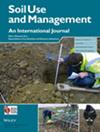Phosphorus dissolution and diffusion from struvite and its impact on phosphorus availability in Acrisol and Cambisol soils
IF 3.7
3区 农林科学
Q1 SOIL SCIENCE
引用次数: 0
Abstract
There is a growing interest in recovering and recycling phosphorus (P) from waste streams to reduce reliance on finite and non-renewable phosphate rock in agriculture. Struvite, derived from waste streams, has emerged as a potential alternative P fertilizer. However, its behaviour in soil remains unclear. This study aimed to investigate the behaviour and effectiveness of struvite as a P fertilizer in acidic Acrisol and calcareous Cambisol soils, focusing on the P dissolution from struvite, struvite P diffusion in soil and P availability. Our findings revealed that the P dissolution from struvite in solution is pH-dependent, with the most dissolution observed at pH 4.5 and significantly less at pH 7.0 and pH 8.5. Consequently, P dissolution from struvite was more rapid in the Acrisol compared with the Cambisol. This was supported by the increased accumulation of water-soluble P in the Acrisol and acid-extractable P in the Cambisol within the 0–1 cm concentric soil section surrounding the struvite application site, as demonstrated in the petri dish experiment. However, the Acrisol exhibited a gradual decrease in P diffusion over time, in contrast to the Cambisol, which showed an increasing trend. This can be attributed to the stronger P fixation observed in the Acrisol. The application of struvite resulted in increased soil P availability, as determined by the diffusive gradients in thin films (DGT) technique, particularly in the Acrisol where struvite was concentrated. Furthermore, the presence of organic acids enhanced struvite P availability in both Acrisol and Cambisol soils. These findings contribute to a better understanding of struvite behaviour in different soil environments and provide valuable insights for optimizing its use as a sustainable and efficient P fertilizer.磷从硬石膏中的溶解和扩散及其对虹吸土壤和寒武土壤中磷可用性的影响
人们对从废物流中回收和循环利用磷(P)以减少农业对有限且不可再生的磷矿石的依赖越来越感兴趣。从废物流中提取的白云石已成为一种潜在的替代磷肥。然而,它在土壤中的表现仍不明确。本研究旨在调查在酸性脆性土壤和钙质寒武土壤中作为磷肥的硬石膏的行为和有效性,重点是硬石膏中磷的溶解、硬石膏在土壤中的扩散以及磷的可用性。我们的研究结果表明,溶液中的钙溶解度与 pH 值有关,pH 值为 4.5 时钙溶解度最高,pH 值为 7.0 和 8.5 时钙溶解度明显降低。因此,与寒武溶胶相比,酸性溶胶中的钙溶解速度更快。正如培养皿实验所证明的那样,在石灰华施用地点周围 0-1 厘米的同心圆土层中,虹膜土壤中的水溶性钾和寒武土壤中的酸萃取钾的累积量都有所增加。不过,随着时间的推移,虹膜土壤中的钾扩散量逐渐减少,而寒带土壤中的钾扩散量则呈上升趋势。这可归因于在虹膜壤中观察到的较强的磷固定作用。根据薄膜扩散梯度(DGT)技术的测定,施用石灰华增加了土壤中 P 的可用性,尤其是在石灰华浓度较高的虹膜层。此外,有机酸的存在也提高了虹膜土壤和寒带土壤中的铁矾土钾含量。这些发现有助于更好地了解不同土壤环境中的硬石膏行为,并为优化硬石膏作为可持续高效钾肥的使用提供了宝贵的见解。
本文章由计算机程序翻译,如有差异,请以英文原文为准。
求助全文
约1分钟内获得全文
求助全文
来源期刊

Soil Use and Management
农林科学-土壤科学
CiteScore
7.70
自引率
13.20%
发文量
78
审稿时长
3 months
期刊介绍:
Soil Use and Management publishes in soil science, earth and environmental science, agricultural science, and engineering fields. The submitted papers should consider the underlying mechanisms governing the natural and anthropogenic processes which affect soil systems, and should inform policy makers and/or practitioners on the sustainable use and management of soil resources. Interdisciplinary studies, e.g. linking soil with climate change, biodiversity, global health, and the UN’s sustainable development goals, with strong novelty, wide implications, and unexpected outcomes are welcomed.
 求助内容:
求助内容: 应助结果提醒方式:
应助结果提醒方式:


